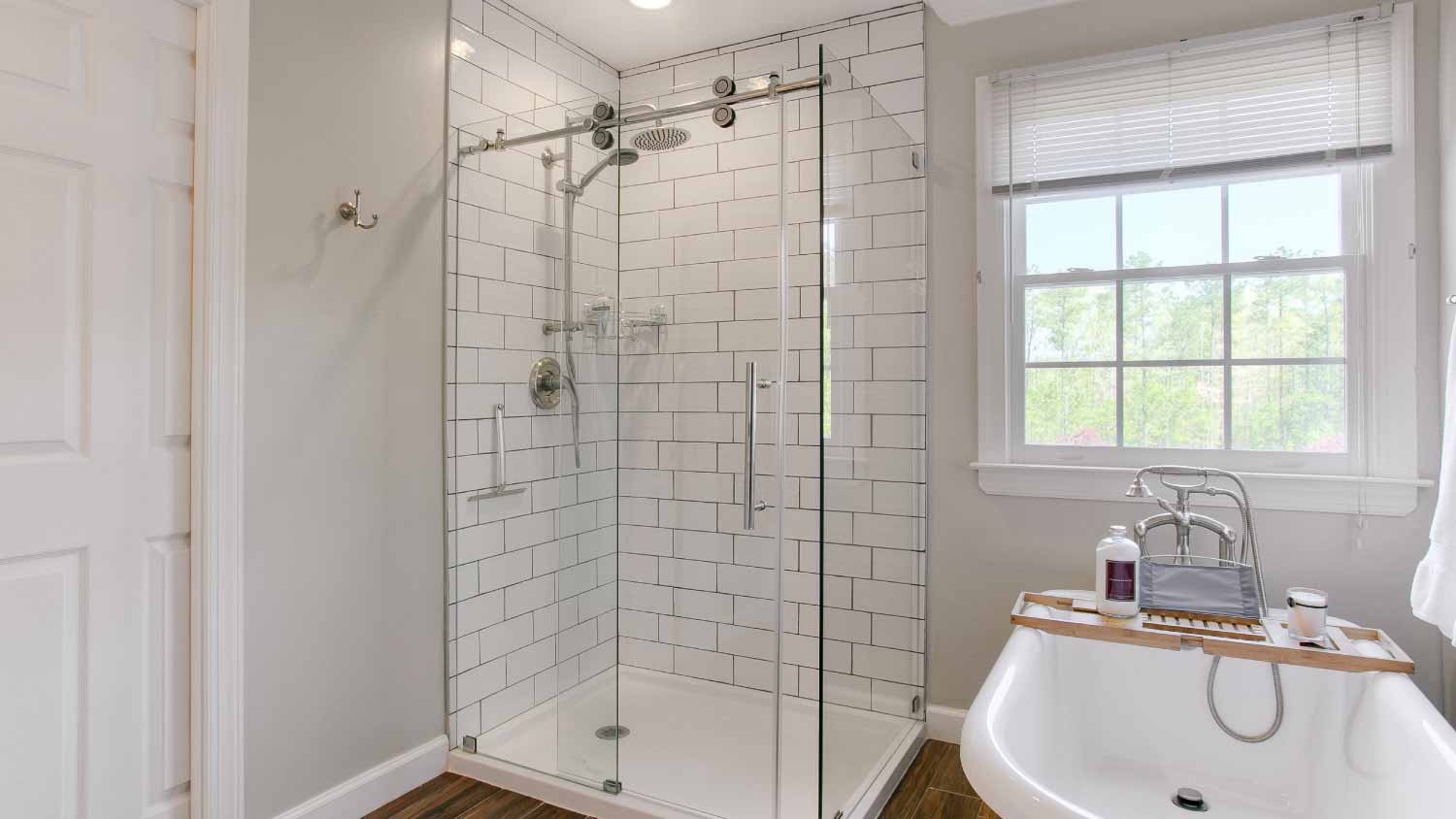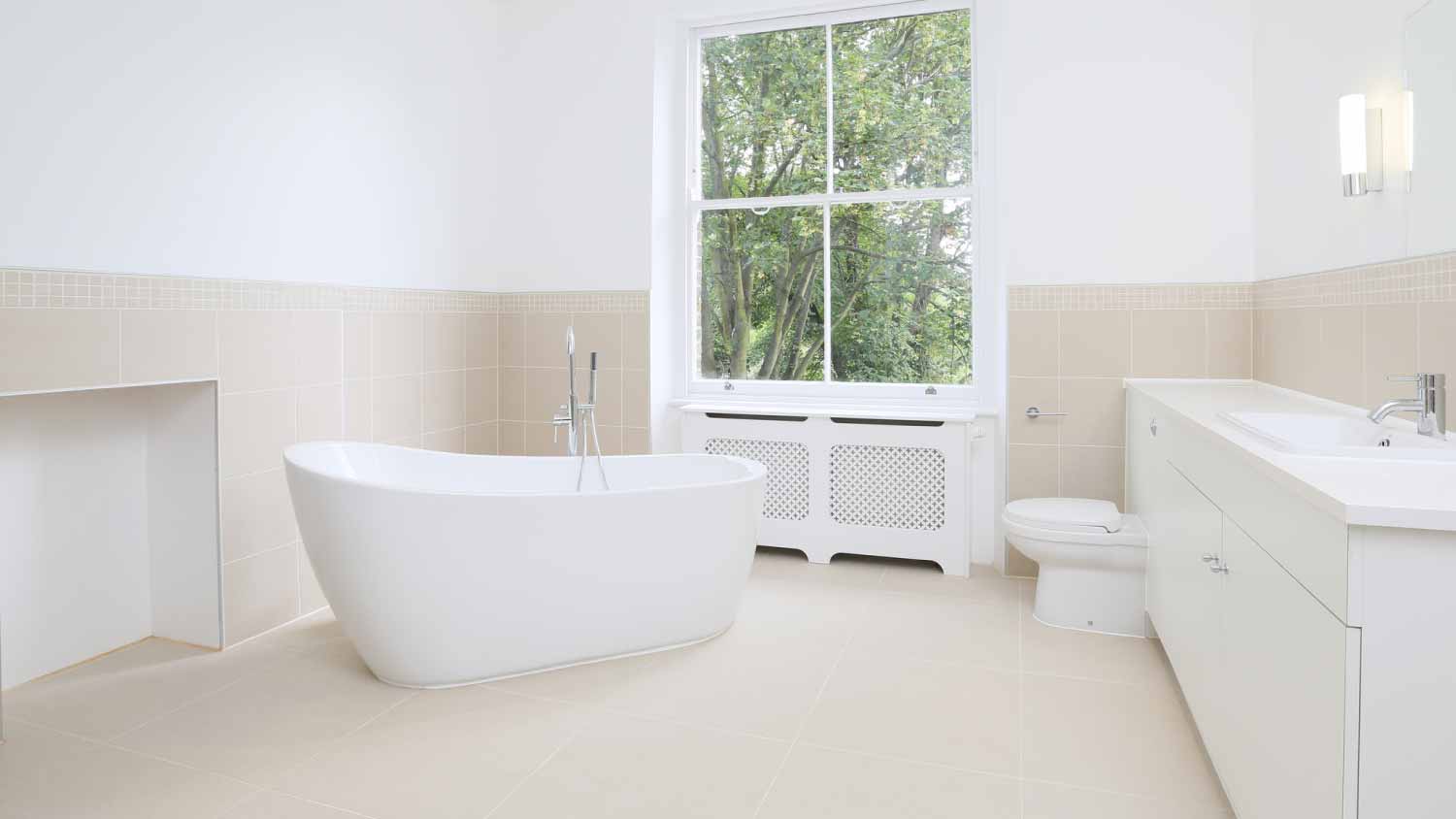What Is a Rain Shower Head?: How It Can Upgrade Your Bathroom
From appearance to cost, there are multiple pros and cons to rain showerheads


A rain showerhead makes just about any bathroom feel luxurious. Imagine the feel of showering with soft rain above your head in your own spa-like bathroom. But when you consider the water spray and difficult installation, it might not be a great option for everyone. Find out what a rain showerhead is, how it compares to regular showerheads, and the pros and cons of installing one in your bathroom.
What Is a Rain Showerhead?
A rain showerhead, also known as a rainfall or waterfall showerhead, is a ceiling-mounted showerhead that sprays water down vertically. It has light water pressure to mimic the feel of rinsing in the rain, so even on your most hectic mornings, you can enjoy a relaxing, serene shower before you start your day.
Rain Showerhead vs. Regular Showerhead
Different types of showerheads have different features and installation methods, but at the end of the day, they’ll both keep you squeaky clean. No matter what type you choose, you’ll find that a new showerhead is a great addition to your bathroom.
“One of the most impactful yet straightforward upgrades a person can do in the bathroom is to change/upgrade their showerheads,” says Chris Alexakis, certified building contractor, design expert, and co-founder of Cabinet Select. “Surprisingly, many people take a good shower for granted, but it can definitely dictate your mood by either being an excellent way to start the day or end a stressful one.”
Here’s a look at the main differences between rain showerheads and regular showerheads.
Mount
Rain showerheads are usually mounted to the ceiling, while regular showerheads are wall-mounted. Some rain showerheads can be mounted high up on the wall, but the arm of the showerhead will extend outward so the water can come down like rain. Rainfall showerheads spray water straight down, while water from a regular showerhead flows at an angle.
Diameter
Rain showerheads are much larger than regular showerheads. A rainfall showerhead usually spans 8, 10, 12, or 14 inches in diameter, while regular showerheads have a 2- to 3-inch diameter. This larger diameter means the water will better envelop your body as you scrub up.
Water Pressure
To give that luxurious feeling of washing yourself in the rain, a rainfall showerhead’s wide diameter helps lighten the amount of pressure of the water. Regular showerheads can have varying water pressures, but generally, they have stronger water pressure compared to rain showerheads.
Pros and Cons of Rain Showerheads

Rain showerheads might seem relaxing, but there are a few drawbacks to keep in mind before you install one in your bathroom.
Pros of a Rain Showerhead
There are many benefits to installing a rain showerhead.
Cleaning: This type of showerhead is very easy to clean because they have anti-clog nozzles. You can simply wipe the showerhead clean with a cloth. The hardest part might be grabbing a step stool to actually reach the ceiling-mounted showerhead.
Technology: There are many high-tech options for rainfall showerheads, like LED lights and air induction, which strengthens the water pressure.
Appearance: Whether it’s a stainless steel rain showerhead or a showerhead with a matte black finish, rainfall showerheads can create a sleek, upscale aesthetic in your bathroom.
Coverage: With the wider showerhead diameter, the water covers more area, so you can be fully enveloped in warm shower water.
Water savings: Rainfall showerheads use about the same amount of water as a regular showerhead, but many rain showerhead models now include water-saving and low-flow features.
Cons of a Rain Showerhead
There are some negatives to the rainfall showerhead to consider.
Cost: Rainfall showerheads are more expensive than regular showerheads. You could spend over $500 on a rain showerhead compared to $30 to $50 for a regular showerhead.
Installation: This type of showerhead is much harder to install, especially when mounted to the ceiling. You’ll need to hire a plumber, because this job requires removing parts of the ceiling and wall and connecting the showerhead to new water piping.
Water pressure: For some people, the lighter water pressure just won’t do. If you prefer higher water pressure, a rain showerhead probably isn’t for you.
Not renter-friendly: Typically, swapping out a showerhead is an easily reversible upgrade that renters can do to make their unit feel more like home. Because installation is so intensive, rainfall showerheads are not a good option for renters.
Choosing the Right Size for a Rain Showerhead
One thing you must keep in mind when choosing a showerhead is the spray. Rainfall showerheads have a wide diameter, so the water spray covers more area. You might be surprised to find water all over the bathroom floor after your first shower with a rainfall showerhead.
Rainfall showerheads are best reserved for showers that are fully enclosed by walls or floor-to-ceiling glass. This option likely won’t work over a claw-foot tub or a tub-shower combination, because the water will spray out onto the floor.
If you have a narrow shower space, you’ll want to look for a rain showerhead with a smaller diameter, around 8 inches, unless you’d like a lot of water coverage. The larger the diameter of the showerhead, the more space the water spray will cover.
As for height, the tallest person in the household using your shower should have about 1 foot of clearance between the top of their head and the showerhead. The rainfall showerhead experience is supposed to be comforting, but that won’t be the case if you or your family members are bumping their heads on it.
Cost of Rainfall Showerhead
The cost of a rainfall showerhead can range widely, but expect to spend $100 to $500 for this fixture. Then, the cost of showerhead installation by a professional will be $200 to over $1,000.
DIY Showerhead Installation vs. Hiring a Pro
You should hire a plumber to install a rain showerhead, because it involves tearing out some of the wall and/or ceiling and adding a new water pipe. You should also consult a professional contractor or plumber to ask about any required inspections or permits before starting this renovation. Unless you have extensive plumbing experience, this is not recommended as a DIY project.





- How to Choose the Best Showerhead
- 13 Types of Showerheads to Buy for Your Bathroom
- How to Change a Showerhead for an Easy Bathroom Upgrade
- How to Choose a Low-Flow Showerhead That Feels Like an Upgrade, Not a Sacrifice
- 4 Possible Reasons Your Shower Is Whistling (And How to Fix Them)
- Showers of the Future: How Technology Will Change
- 5 Causes of a Leaking Shower and How to Fix It
- Get the Space You Deserve With These 10 Split Primary Bathroom Ideas
- 9 Shower Remodeling Ideas for an Instant Upgrade
- 17 Stunning Outdoor Shower Ideas and Designs










